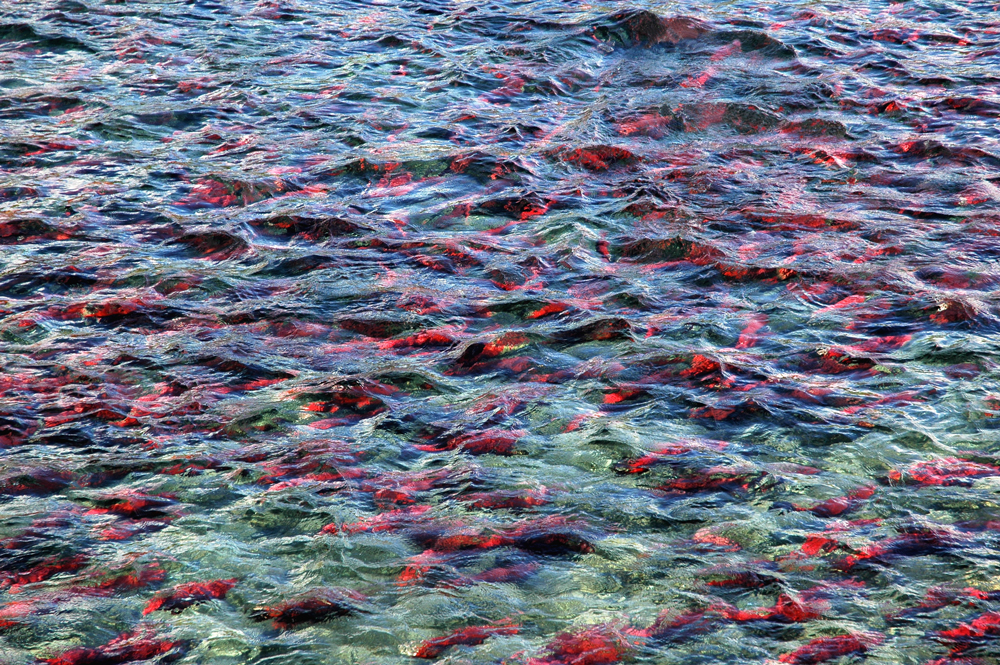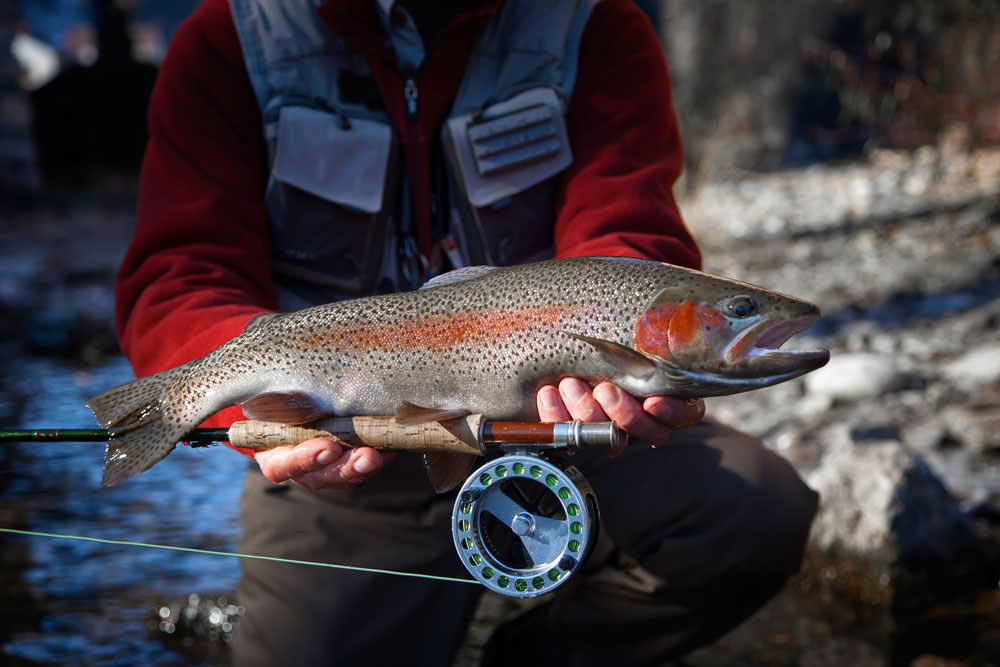DILLINGHAM, ALASKA (JULY 30)
The middle fork of the Good News River is thick with spawning sockeye and chum salmon. Bull sockeye, brilliant with their vermillion bodies and olive heads, chase interlopers away from hens on their redds. Chum, worn from procreating next season’s parr, cruise this chest-deep run aimlessly as their flanks degenerate, taking on vertical, muted swaths of yellow, red, and green, their jaws growing kypes and ferocious teeth.
So numerous are the salmon that it becomes challenging to get our bugs—in this case, plastic orbs the size and pinkish orange of freshly deposited eggs—down into the zone where ’bows, Dollies, and grayling feed. We fish six-weights with ten-pound-test tippets below white bubble strike indicators. From our 18-foot aluminum skiffs, buffeted by incessant windy chop, we can see the salmon easily in water that would be colorless were it not for a faint hint of tannin.
This week I am fishing out of Bristol Bay Lodge, Sporting Classic’s Fishing Lodge of the Year for 2017. Steve Laurent, owner and maestro of the lodge, has divided us into a squad of four, stuffed us in rotary-engined Beavers, and had us flown to Birch Camp on the river. We’ve stashed our gear in WeatherPort tents, met our guides—Jared Koenigsfeld and Eric Mannon—and rigged our rods.
For this trip, I’d brought a pair of eight-weight graphite travel rods short enough to fit in a briefcase, a seven-piece Orvis Trident, and a six-piece Thomas & Thomas Vagabond. But the rod I really wanted to fish is the Woolman bamboo six-piece, six-weight which Lou Dendero repaired for me. I figured it’d be just right for Dolly Varden and grayling. Rainbows could put more of a strain on the rod than I’d intended. If need be, the eight-weights could do for huge ’bows and any salmon except kings. I wouldn’t target salmon with bamboo.
Chris, my lady friend who’s learning to fly fish, and I flew into Anchorage on Thursday, overnighted at The LakeFront on the floatplane base, picked up last-minute gear in town on Friday, and caught the ACE air charter to Dillingham on Saturday. Steve met us and the 18 other guests at the airport and ferried us, first by van and then by boat, to the lodge. That night he told us that in the morning we’d head out to Birch Creek, the lodge’s spike camp on the middle fork of the Good News River.
Birch is all that a spike camp could ever be. Guest overnight, two to a tent, in the trio of wood-floored WeatherPorts on the boardwalk. The bath house sits opposite the cook tent-cum-dining room. And Jared and Eric hole up in a tent by the boat launch, which they share with Michael Pickreign.
Pickreign’s no ordinary camp cook. With a degree in the culinary arts, he turns out the likes of blueberry crepes drizzled with dark chocolate as a precursor to breakfast. Here, there’s no reason at all not to eat desert first. I wolfed it down. I needed all the extra energy I could get to fight fish in these waters.

The river turns red as sockeye salmon course up Alaska’s streams. (Photo: brytta/iStock)
Our guide, Jared, was kind enough not to object too strenuously when I insisted on fishing with the cane rod. He was sure I’d bust it. I didn’t think so and rigged it with the standard egg below a strike indicator. For half an hour we skimmed up the river in our skiff, sliding the boat right and left to keep the bow pointed into the heaviest current. On station, Jared rolled over the gunwale and began to walk the boat down the riffles. Here and there the river darkened, indicating more depth than the thigh-deep shallows.
Wanting Chris to learn how to handle a fish bigger than most western North Carolina trout ever grow, I offered her the bow platform. Jared instructed her gently, letting her know that casts of 20 feet or so were perfectly ample, that soft upstream mends would keep her egg drifting naturally, and that all that was required to hook a fish was a fast and firm lift of the rod tip. Novice anglers feel right at home at Bristol Bay Lodge.
Her first fish was a two-pound grayling followed by a nice 16-inch ’bow and a handsome Dolly whose belly was just turning orange. Both fought doggedly, and she handled them with aplomb.
Though Jared had told her how fast rainbows ran, Chris was unprepared for the speed of the one who took her offering. But she kept her rod tip up, judiciously fed it the loose line, and transferred the fish to the reel as expertly as if she had been fishing for years. Landing that ’bow made her feel like a full-fledged angler, ready to take on with her fly rod whatever freshwater would offer.
Bowing to Jared’s wishes, I fished the T&T eight-weight and felt the power of the grayling, rainbows, and Dolly Varden typical of this run of the Good News in late July. Then I switched to the six-piece cane rod, landed a couple more Dollies, and was getting into the swing of the routine when my egg drifted through a pod of sockeye.
They’re not feeding any more but are really defensive of their redds. Evidently, we figured later, one slashed at my fly and inadvertently hooked itself in its mouth. I saw roll, felt the strike, transferred the line to my vintage Pflueger Medalist, and hoped I wasn’t about to break the bamboo rod. Fortunately, this section of the Good News is wide, shallow, and as free of obstructions as many sections of the Madison.
The salmon had plenty of room to run, and I let it, but always keeping the rod bent to what I figured was about 75 percent of its capacity. I left myself a little margin should the fish lunge unexpectedly. And I knew that if pressure really threatened to break the rod, I could always point the tip at the fleeing salmon and break it off. I didn’t have to, though. After what seemed like 30 minutes but was probably less than half that, I brought the fish close enough to the boat that Jared could swoop it into his net.
That was the first of three salmon I’ve landed in the past couple of days. I’m not going to target them, preferring rainbows, grayling, and Dollies instead. If ever there a place and time where trout, salmon, and grayling are so abundant, I don’t know anywhere better than the waters fished by Steve Laurent and his crew at Bristol Bay Lodge in late July.
For more information about Bristol Bay Lodge, visit fishasl.com/bristol-bay-lodge.

